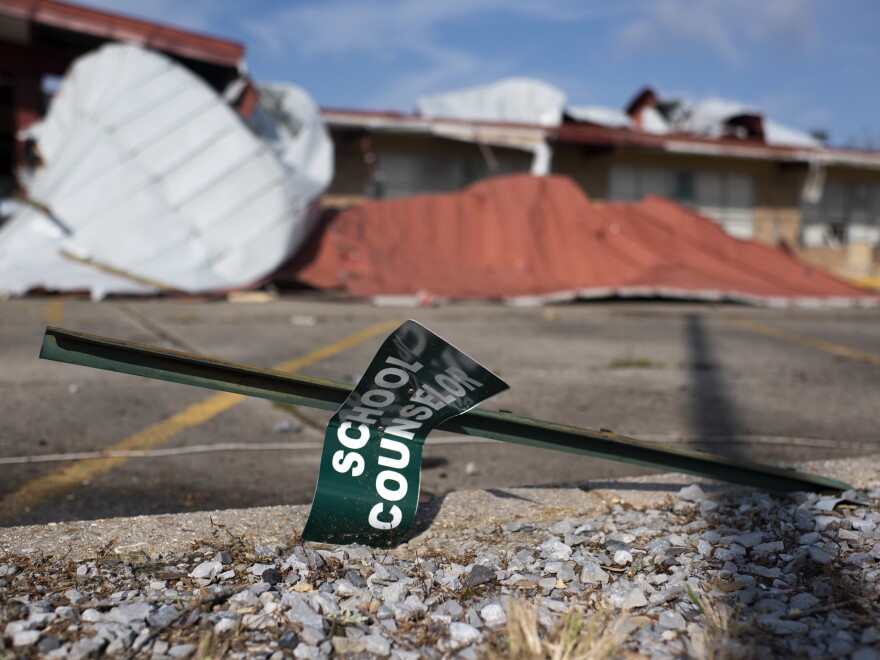After starting the school year in-person, teacher Susan Adams is once again stuck at home, waiting for her school building to reopen. Adams teaches high school English in Terrebonne Parish, on Louisiana's Gulf Coast, an area that saw significant storm damage from Hurricane Ida almost two weeks ago.
"We all knew that there was definitely going to be water in the school, but the extent of the water in the school is kind of mind-blowing," she said in a phone interview.
More than 250,000 K-12 students in Louisiana are still waiting for classrooms to reopen after Ida tore through the state. With power now restored to some areas, including most of New Orleans, many schools plan to resume classes next week. But some communities, especially those in the state's hard-hit river and coastal parishes, like Terrebonne, don't expect to get electricity back until late September, and building repairs could keep students out of the classroom well into October.
That means more than 45,000 Louisiana students are facing a month or more of school closures.
Ida devastated some school communities
Adams has been able to assess the damage to her school, South Terrebonne High School, on frequent visits to the National Guard aid station that's set up nearby and through pictures shared by school leaders. She said the walls and floors are slick with mud, the windows are blown out and pieces of the roof are strewn everywhere.
She has spent 20 years teaching at South Terrebonne, and she describes the school as her "home away from home." Her son is a sophomore there, and her husband coaches the football team. She and her family are relying on a generator to run an air-conditioning unit at night so they're comfortable enough to sleep. Their home is still without running water.
Adams said her son is miserable with the football season postponed indefinitely, and she expects that her students feel similarly.
"Do you know how many of my students stayed and lived through the storm, like they stayed and didn't evacuate? I think quite a few. I think quite a few lost quite everything they had. We're going to have to love those kids hard when we go back."
For now, she has been using her cellphone to occasionally send her students uplifting messages on Google Classroom.
"I just told them it's OK to grieve, but give yourself a time limit and then go out and help your community," she said.
Louisiana State Superintendent of Education Cade Brumley said Tuesday that he expects between 50,000 and 75,000 students to return to the classroom in the next week, now that electricity has been restored to some parts of the state, including New Orleans and Baton Rouge.
What the road to recovery looks like for schools
Electricity is just one part of the equation. Severe building damage in the state's river parishes as well as in parts of Jefferson Parish, which houses the state's largest public school district, may cause lengthier school closures and significant funding challenges.
That's a situation that Karl Bruchhaus, superintendent of Calcasieu Parish schools, is all too familiar with. A year ago, his district was devastated by Hurricane Laura, another Category 4 storm. Bruchhaus said most of the district's school buildings were significantly damaged by the storm, and school leaders initially attempted to keep school going online. But even after power was restored, widespread internet outages made learning virtually impossible for most students.
It became clear that students needed to be back in classrooms, Bruchhaus explained, and the district worked to reopen less damaged school buildings as quickly as possible.
But more than a year later, he said his district still hasn't been able to repair the bulk of hurricane damage to school buildings. According to Bruchhaus, there just isn't the money for it: Calcasieu Parish's public schools suffered an estimated $400 million in building damage from hurricanes last year, and according to the district, it has only received $116,000 in assistance from the Federal Emergency Management Agency so far. In response to NPR's request for comment, a spokesperson for FEMA said the agency was "looking into the situation."
"There's just hurdle after hurdle after hurdle," Bruchhaus said. "If it's not the federal process, then when it gets to the state, there's another process and, you know, our vendors, they're not going to work for free."
In the meantime, students and teachers are still going to school in the damaged buildings.
"They're going to school with concrete floors and no tile on the floor. They're going to school with roof leaks when it rains," Bruchhaus said. "They're accepting all of that, and frankly, we're having a pretty good instructional year, absent the COVID issue, which is a daily debacle."
His message to school leaders who have been hit hard by Ida is to focus on the students and not let this storm derail their education.
Copyright 2024 WWNO - New Orleans Public Radio



